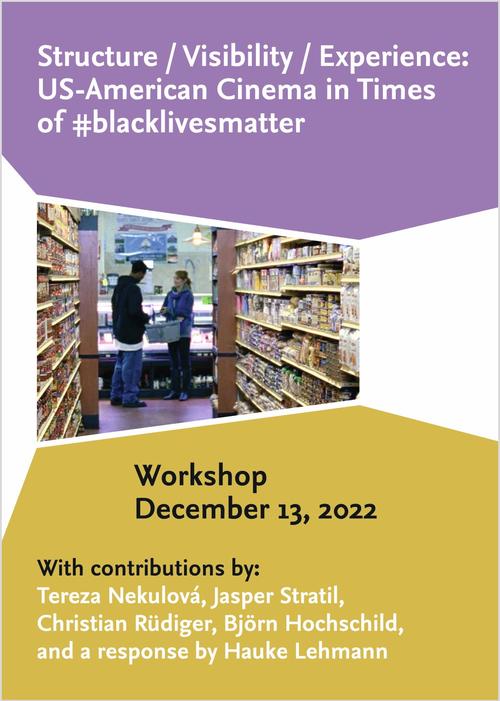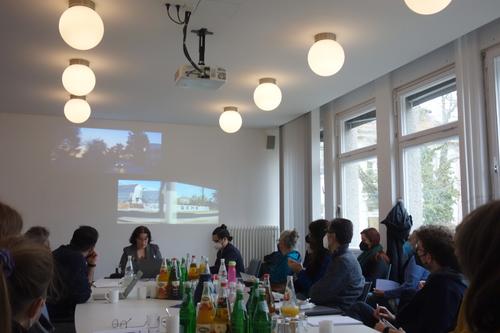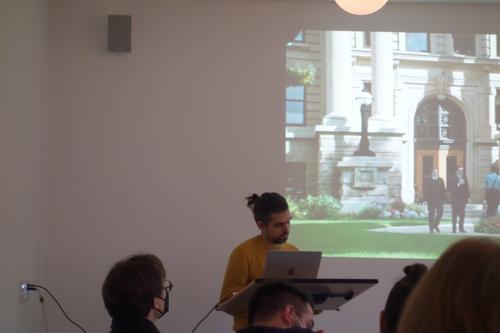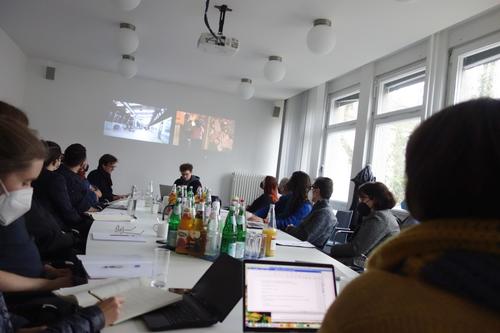Structure / Visibility / Experience: US-American Cinema in Times of #blacklivesmatter
13.12.2022 | Workshop der Kolleg-Forschungsgruppe Cinepoetics mit Tereza Nekulová, Jasper Stratil, Christian Rüdiger, Björn Hochschild und Hauke Lehmann.
Research Focus: Digital Cultures II: Phenomenology of the Anthropocene
The workshop started with an introductory statement by Björn Hochschild and Christian Rüdiger on their recent work on racism and police brutality in times of the #blacklivesmatter movement. Choosing to approach these topics through film, they focus on phenomenological aspects, elaborating on how film relates itself to the terms structure, visibility and experience, and how it connects these terms to one another.
In their joint presentation “Spaces Framing Structures: Predestined Coincidences in Fruitvale Station,” Björn Hochschild and Christian Rüdiger went on by asking how to make a structure visible that tends to be invisible. Drawing on the impression of an alignment of the spaces in time, as if the protagonist’s journey leading to his murder is predestined, Hochschild and Rüdiger elaborated on how most of the images have vanishing lines mainly within the frame. This may activate a certain mode of suspense and spatial orientation as the eminent death becomes more tangible. Furthermore, they related their findings on social-temporal orientation to theoretical perspectives on Afro Pessimism and Black Optimism in order to think race through this process of cinematic orientation.
Tereza Nekulová's talk, “Looking and Looking Back: Melancholic Viewership in Queen & Slim,” presented various theory fragments, while combining the images of the film with observations on Black viewership, melancholy, and loss.
Nekulová talked about the coexistence of different temporalities and rhythms in the film as well as a dominant movement into the depth of the image. The car window may react as a frame that sets pictures of landscapes and people into motion, creating image fragments involved in the same movement. Occurring dissonances between sound and image may include a certain sense of possibility of a shared future of the two protagonists on the run, while Nekulová underlined that the past presents itself as a lost possibility in the film, evoking a melancholic mode. Becoming available to reflection by breaking the coherence of meaning in film, the bodies of the protagonists inherent the possibility to embody the lives of black people in America and all over the world, living in a space that does not include them.
In his presentation, “Critical Horizons. Situating Detroit in Perspective of #blacklivesmatter,” Jasper Stratil talked about the film Detroit in connection to a mode of discomfort of being part of a world that legitimizes injustice as it is based on a real life event, the Detroit Riots in 1967.
As the film shifts from a documentary perspective to a fictional one, it is rather a mode of experience of an actual being-there than a reenactment of a real life event. This mode of experience is underlined by archival footage and changing genre aspects that emphasize a shift of perspective while inhering a function of authenticity. Therefore, these images may function as a mode of experience that does not outlast as an individual trauma but a community experience, fading the lines between private and public space. Stratil concluded that the shared memory of pain as an embodied experience reflects on the viewers experience as the film rather vaguely makes the structurality of racism visible, as the fictionalized police brutality is depicted as individual.
In a response to each presentation, Hauke Lehmann connected the question of visibility to a lack of representation that is, moreover, connected to racism, as well as the question of invisibility as off screen and imaginary space.
Starting with a comment on the first presentation, he pointed out that the mentioned vanishing points start and end with the death of the protagonist, underlining the predestination. He did not agree with the mode of suspense, as Fruitvale Station operates in a mode of the already certain, attempting to stage the present although without any room for the present movement to evolve.
Moving on with the second presentation, the car itself in a road movie becomes a substitute for the camera, as everything transforms into images. Lehmann also mentioned the absence of Black protagonists in Hollywood road movies and concluded by talking about identity as something inscribed into the image.
He continued by commenting on the third presentation, drawing a connection to the paranoia cinema of the 1970s. He talked about the confusion between art and journalism, as the restaging of the images seems like a reenactment of the past as well as some kind of reconstruction that leads to draining the present, leaving no space for future change.



